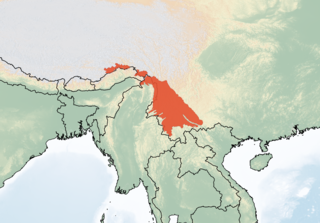
The Arvicolinae are a subfamily of rodents that includes the voles, lemmings, and muskrats. They are most closely related to the other subfamilies in the Cricetidae. Some authorities place the subfamily Arvicolinae in the family Muridae along with all other members of the superfamily Muroidea. Some refer to the subfamily as the Microtinae or rank the taxon as a full family, the Arvicolidae.

Microtus is a genus of voles found in North America, Europe and northern Asia. The genus name refers to the small ears of these animals. They are stout rodents with short ears, legs and tails. They eat green vegetation such as grasses and sedges in summer, and grains, seeds, root and bark at other times. The genus is also called "meadow voles".

The water voles are large voles in the genus Arvicola. They are found in both aquatic and dry habitat through Europe and much of northern Asia. A water vole found in Western North America was historically considered a member of this genus, but has been shown to be more closely related to members of the genus Microtus. Head and body lengths are 12–22 cm, tail lengths are 6.5–12.5 cm, and their weights are 70–250 g. The animals may exhibit indeterminate growth. They are thick-furred and have hairy fringes on their feet that improve their swimming ability.
Neacomys musseri, also known as Musser's neacomys or Musser's bristly mouse, is a rodent species from South America. It is found in far western Brazil and southeastern Peru.
The white-tailed mountain vole is a species of vole in the family Cricetidae. It is found in India and Pakistan.
The southern mole vole is a species of rodent in the family Cricetidae. It is found in Afghanistan, Iran, Pakistan, and Turkmenistan.

The Transcaucasian mole vole is a species of rodent in the family Cricetidae.
Musser's shrew mouse is a species of rodent in the family Muridae. It is found only in Papua New Guinea. Its natural habitat is subtropical or tropical moist montane forests.
The Japanese red-backed vole, Wakayama red-backed vole, or Anderson's red-backed vole is a species of rodent in the family Cricetidae. It is found only on the island of Honshu in Japan. It was first described by the British zoologist Oldfield Thomas in 1905. Thomas named it in honor of scientific collector Malcolm Playfair Anderson. The International Union for Conservation of Nature lists it as "least concern".

Clarke's vole is a species of rodent in the family Cricetidae. It is found only in China.
Volemys is a small genus of rodents in the family Cricetidae. It contains the following species, both of which are endemic to China:
The Szechuan vole is a species of rodent in the family Cricetidae. It is found only in northwestern Sichuan, China. It is one of two species in the genus Volemys along with Marie's vole.





